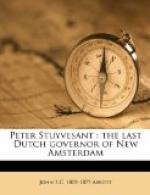“The noise of muskets,” writes Brodhead, “mingled with the shrieks of the terrified Indians. Neither age nor sex were spared. Warrior and squaw, sachem and child, mother and babe, were alike massacred. Daybreak scarcely ended the furious slaughter. Mangled victims, seeking safety in the thickets, were driven into the river. Parents, rushing to save their children whom the soldiers had thrown into the stream, were driven back into the waters and drowned before the eyes of their unrelenting murderers.”
“I sat up that night,” writes DeVrees,
“by the kitchen fire at the Director’s. About midnight, hearing loud shrieks, I ran up to the ramparts of the fort. Looking towards Pavonia, I saw nothing but shooting, and heard nothing but the shrieks of Indians murdered in their sleep.”
With the dawn of the morning the victorious Dutch returned from their scene of slaughter, bearing with them about thirty prisoners, and the heads instead of the scalps of many warriors. Kieft welcomed these blood-stained men with “shaking of hands and congratulations.” The tidings of this outrage spread far and wide among the Indian tribes in the valley of the Hudson and on the Long Island shore.
Private enterprise, relying upon the protection of Kieft, had sent out a foraging expedition upon Long Island. Kieft assumed that he saw signs of hostility there. The unsuspecting savages were plundered of two wagon loads of grain. These Indians, who had thus far been the warmest friends of the Dutch, were now justly roused to the highest pitch of indignation. They immediately made common cause with the river tribes, who were almost frenzied with the desire to avenge the midnight massacres of Pavonia and Manhattan. The storm which thus burst upon New Netherland was sudden and awful. The savages, in their rage, developed energy and power totally unanticipated.
Eleven tribes combined in the most furious and merciless attacks upon the lonely farm-houses. Everywhere the war-whoop resounded, and the plumed and painted savages emerged from swamps and thickets, and assailed every unprotected dwelling. The farmer was shot in the field, his dwelling burned, and his wife and children were thrown into the flames. Many women and children, their lives being spared, were carried into captivity worse than death. Houses, haystacks and granaries were fired. Cattle were slain or driven off, and crops destroyed.
Terror held high carnival. From the banks of the Raritan to the valley of the Housatonic, over a region of hundreds of square miles, not a plantation was safe. Men, women and children, haggard with hunger, exposure and woe, fled from their deserted homes to fort Amsterdam. Despairing of ever again finding peaceful residence in this new world, with one voice they demanded a return to the fatherland. The Dutch colonies were threatened with immediate and entire depopulation.




